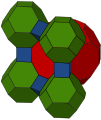Talk:Alternation (geometry)
| This article is rated Start-class on Wikipedia's content assessment scale. It is of interest to the following WikiProjects: | |||||||||||
| |||||||||||
dots and rings[edit]
In the examples shown here, all nodes of the CD graph are hollow rings — but I think somewhere or other I've seen CD graphs where some nodes were hollow and others were either ringed or unringed. What's possible? If one node is hollow, must all nodes of the connected subgraph be hollow? —Tamfang (talk) 01:15, 9 January 2009 (UTC)
- The uniform polychoral prisms have some mixing holes and rings, but separated by right angles.
- The Snub_24-cell mixes unringed nodes and holes. (Similarly the tetrahedron as an alternated cube has unringed nodes)
- Richard Klitzing said he developed a consistent definition of mixing rings and holes, never challenged him on it. As far as I know Coxeter never mixed rings and holes, and the alternation would be considered the final operation. Tom Ruen (talk) 02:01, 9 January 2009 (UTC)
- I think I get it now. I had the idea that a hole represents a mirror that changes parity while a ringed or unringed dot represents a normal mirror. Rather, the holes mean that the vertex is present in "even" cells — and holes plus ringed dots are not possible. —Tamfang (talk) 00:43, 10 January 2009 (UTC)
- Something like that, but really it is "post-mirror" operation. It takes a mirrored figure and removes all even or odd reflections. Tom Ruen (talk) 00:50, 10 January 2009 (UTC)
Speaking about alternation, guessing about what I might have done: so please, read was is already written at [1] on this subject. — Dr. Richard Klitzing, 16. March 2009 —Preceding unsigned comment added by 87.165.126.62 (talk) 21:36, 16 March 2009 (UTC)
- Is that now http://bendwavy.org/klitzing/explain/dynkin.htm#snub ? —Tamfang (talk) 02:06, 18 January 2011 (UTC)
"Fully truncated"[edit]
The article begins "In geometry, an alternation .. is an operation .. that fully truncates alternate vertices". For someone who has previously read the articles Truncation and Rectification (quite a likely route for reaching this article) this use of "fully truncate" is confusing. Both articles show a series which goes "1/4 truncated, uniform truncated, 3/4 truncated, rectified". Rectification follows it up with a series that goes "1/4 truncated, uniform truncated, 3/4 truncated, rectified, .., .., .., birectified". A reader of this article might think that its "fully truncates" corresponds to their "[100%] truncated". It doesn't. It corresponds to Rectification's "birectified".
I suggest changing "In geometry, an alternation .. is an operation .. that fully truncates alternate vertices" to read "In geometry, an alternation .. is an operation .. that birectifies alternate vertices (see Rectification)". 80.176.236.13 (talk) 11:54, 16 July 2009 (UTC)
Sorry, that was me, I had got logged out somehow: Maproom (talk) 12:27, 16 July 2009 (UTC)
One more honeycomb alternation example[edit]
From Cantitruncated cubic honeycomb#Alternation we see that:
-
Alternating this...
-
...yields this.
Although there's no particular name for the two chiral alternations of the Cantitruncated Cubic Honeycomb, can't we still add this as an example in the Higher dimensions section? 13.8.137.10 (talk) 04:31, 27 January 2011 (UTC)
snubification in a separate article ?[edit]
Hello,
The fact that this article covers both alternation and snubification generates problems with the interwikis : the Portuguese article about "snubification" is linked to an English article named "Alternation". See the wikidata page to understand what I mean. The solution would of course to split the English article. --MathsPoetry (talk) 10:01, 2 May 2013 (UTC)
- Snub (geometry) has now been split off. Tom Ruen (talk) 07:58, 26 July 2014 (UTC)
Mathworld?[edit]
This was amid the citations. To me, that page appeared blank and empty of content; so I tried the Wayback machine, I tried some cached versions; All of which were blank as well. I assume this citation may have been added righteously and that I may have been unable to view that content (which is why I didn't remove the citation).
May someone give me an explanation? Existent human being (talk) 18:41, 31 August 2021 (UTC)



